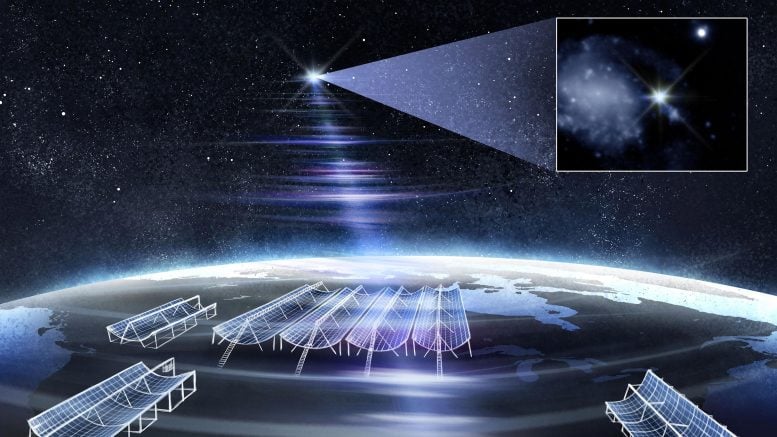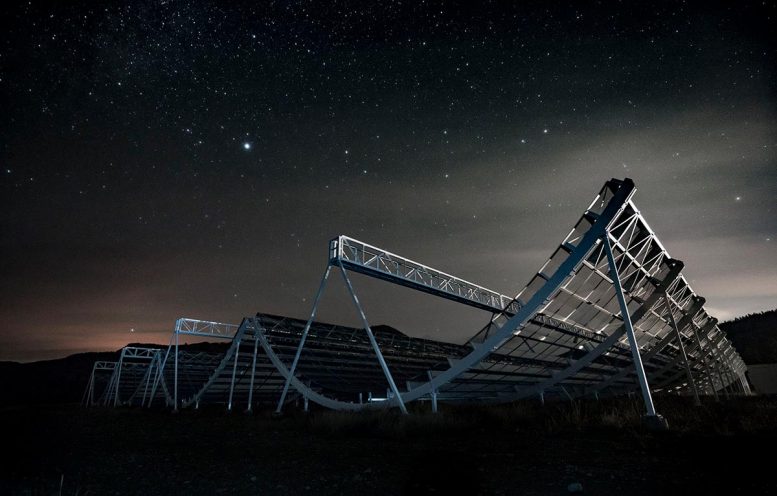
A cosmic blast called “RBFLOAT” has been found just 130 million light-years away, making it the brightest and closest fast radio burst ever seen.
Thanks to CHIME’s new Outriggers, scientists traced it to the edge of a galaxy’s star-forming region, hinting at an older magnetar as the source.
A Flash Across the Universe
A fast radio burst is a powerful surge of radio energy that lasts only a few thousandths of a second. During that fleeting instant, it can shine more brightly than every other radio source in its home galaxy. These extraordinary flashes are so intense that their signals can be detected from billions of light-years away, across half the universe.
Exactly what produces these bursts is still a mystery. Now, researchers have the rare opportunity to examine one in far greater detail than ever before. An international group of scientists, including physicists at MIT, has identified an exceptionally bright fast radio burst (FRB) located about 130 million light-years from Earth in the constellation Ursa Major. This event is among the nearest FRBs ever found and also the brightest on record. Its brilliance earned it the informal nickname RBFLOAT, short for “radio brightest flash of all time.”
Because this burst is both unusually close and extraordinarily luminous, it provides scientists with their best chance yet to investigate FRBs and the environments where they form.
“Cosmically speaking, this fast radio burst is just in our neighborhood,” says Kiyoshi Masui, associate professor of physics and affiliate of MIT’s Kavli Institute for Astrophysics and Space Research. “This means we get this chance to study a pretty normal FRB in exquisite detail.”
Masui and his colleagues reported their findings on August 21 in the Astrophysical Journal Letters.

CHIME Telescope Upgrades Sharpen the View
The ability to capture this event so clearly came from recent improvements to the Canadian Hydrogen Intensity Mapping Experiment (CHIME), a large radio telescope made up of long, curved antennae in British Columbia. CHIME was originally built to map hydrogen across the universe, but it also happens to be sensitive to fast, powerful radio signals. Since beginning operations in 2018, it has detected around 4,000 FRBs from all directions in the sky. Until recently, however, CHIME could not determine the exact origin of these bursts.
That changed with the addition of CHIME Outriggers, three smaller companion arrays located at different sites across North America. Working together, CHIME and its Outriggers act like a continent-sized telescope, able to zero in on bright bursts and pinpoint their exact location with remarkable accuracy.
“Imagine we are in New York and there’s a firefly in Florida that is bright for a thousandth of a second, which is usually how quick FRBs are,” says MIT Kavli graduate student Shion Andrew. “Localizing an FRB to a specific part of its host galaxy is analogous to figuring out not just what tree the firefly came from, but which branch it’s sitting on.”
Pinpointing a Burst on the Edge of a Galaxy
The new fast radio burst is the first detection made using the combination of CHIME and the completed CHIME Outriggers. Together, the telescope array identified the FRB and determined not only the specific galaxy, but also the region of the galaxy from where the burst originated. It appears that the burst arose from the edge of the galaxy, just outside of a star-forming region. The precise localization of the FRB is allowing scientists to study the environment around the signal for clues to what brews up such bursts.
“As we’re getting these much more precise looks at FRBs, we’re better able to see the diversity of environments they’re coming from,” says MIT physics postdoc Adam Lanman.
Lanman, Andrew, and Masui are members of the CHIME Collaboration, which includes scientists from multiple institutions around the world, and are authors of the new paper detailing the discovery of the new FRB detection.
Each of CHIME’s Outrigger stations continuously monitors the same swath of sky as the parent CHIME array. Both CHIME and the Outriggers “listen” for radio flashes, at incredibly short, millisecond timescales. Even over several minutes, such precision monitoring can amount to a huge amount of data. If CHIME detects no FRB signal, the Outriggers automatically delete the last 40 seconds of data to make room for the next span of measurements.
A Surprising Source: Older Magnetar?
On March 16, 2025, CHIME detected an ultrabright flash of radio emissions, which automatically triggered the CHIME Outriggers to record the data. Initially, the flash was so bright that astronomers were unsure whether it was an FRB or simply a terrestrial event caused, for instance, by a burst of cellular communications.
That notion was put to rest as the CHIME Outrigger telescopes focused in on the flash and pinned down its location to NGC4141 — a spiral galaxy in the constellation Ursa Major about 130 million light-years away, which happens to be surprisingly close to our own Milky Way. The detection is one of the closest and brightest fast radio bursts detected to date.
Follow-up observations in the same region revealed that the burst came from the very edge of an active region of star formation. While it’s still a mystery as to what source could produce FRBs, scientists’ leading hypothesis points to magnetars, young neutron stars with extremely powerful magnetic fields that can spin out high-energy flares across the electromagnetic spectrum, including in the radio band. Physicists suspect that magnetars are found in the center of star formation regions, where the youngest, most active stars are forged. The location of the new FRB, just outside a star-forming region in its galaxy, may suggest that the source of the burst is a slightly older magnetar.
“These are mostly hints,” Masui says. “But the precise localization of this burst is letting us dive into the details of how old an FRB source could be. If it were right in the middle, it would only be thousands of years old — very young for a star. This one, being on the edge, may have had a little more time to bake.”
One-Off or Repeating Mystery?
In addition to pinpointing where the new FRB was in the sky, the scientists also looked back through CHIME data to see whether any similar flares occurred in the same region in the past. Since the first FRB was discovered in 2007, astronomers have detected over 4,000 radio flares. Most of these bursts are one-offs. But a few percent have been observed to repeat, flashing every so often. And an even smaller fraction of these repeaters flash in a pattern, like a rhythmic heartbeat, before flaring out. A central question surrounding fast radio bursts is whether repeaters and nonrepeaters come from different origins.
The scientists looked through CHIME’s six years of data and came up empty: This new FRB appears to be a one-off, at least in the last six years. The findings are particularly exciting, given the burst’s proximity. Because it is so close and so bright, scientists can probe the environment in and around the burst for clues to what might produce a nonrepeating FRB.
“Right now, we’re in the middle of this story of whether repeating and non-repeating FRBs are different. These observations are putting together bits and pieces of the puzzle,” Masui says.
“There’s evidence to suggest that not all FRB progenitors are the same,” Andrew adds. “We’re on track to localize hundreds of FRBs every year. The hope is that a larger sample of FRBs localized to their host environments can help reveal the full diversity of these populations.”
Reference: “FRB 20250316A: A Brilliant and Nearby One-off Fast Radio Burst Localized to 13 pc Precision” by Thomas C. Abbott, Daniel Amouyal, Bridget C. Andersen, Shion E. Andrew, Kevin Bandura, Mohit Bhardwaj, Kalyani Bhopi, Yash Bhusare, Charanjot Brar, Alice Cai, Tomas Cassanelli, Shami Chatterjee, Jean-François Cliche, Amanda M. Cook, Alice P. Curtin, Evan Davies-Velie, Matt Dobbs, Fengqiu Adam Dong, Yuxin Dong, Gwendolyn Eadie, Tarraneh Eftekhari, Wen-fai Fong, Emmanuel Fonseca, B. M. Gaensler, Nina Gusinskaia, Jason W. T. Hessels, Danté M. Hewitt, Jeff Huang, Naman Jain, Ronniy. C. Joseph, Lordrick Kahinga, Victoria M. Kaspi, Afrasiyab (Afrokk) Khan, Bikash Kharel, Adam E. Lanman, Magnus L’Argent, Mattias Lazda, Calvin Leung, Robert Main, Lluis Mas-Ribas, Kiyoshi W. Masui, Kyle McGregor, Ryan Mckinven, Juan Mena-Parra, Daniele Michilli, Nicole Mulyk, Mason Ng, Kenzie Nimmo, Ayush Pandhi, Swarali Shivraj Patil, Aaron B. Pearlman, Ue-Li Pen, Ziggy Pleunis, J. Xavier Prochaska, Masoud Rafiei-Ravandi, Scott M. Ransom, Gurman Sachdeva, Mawson W. Sammons, Ketan R. Sand, Paul Scholz, Vishwangi Shah, Kaitlyn Shin, Seth R. Siegel, Sunil Simha, Kendrick Smith, Ingrid Stairs, David C. Stenning, Haochen Wang, Thomas Boles, Ismaël Cognard, Tammo Jan Dijkema, Alexei V. Filippenko, Marcin P. Gawroński, Wolfgang Herrmann, Charles D. Kilpatrick, Franz Kirsten, Shawn Knabel, Omar S. Ould-Boukattine, Hadrien Paugnat, Weronika Puchalska, William Sheu, Aswin Suresh, Aaron Tohuvavohu, Tommaso Treu and WeiKang Zheng, 21 August 2025, The Astrophysical Journal Letters.
DOI: 10.3847/2041-8213/adf62f
The construction of the CHIME Outriggers was funded by the Gordon and Betty Moore Foundation and the U.S. National Science Foundation. The construction of CHIME was funded by the Canada Foundation for Innovation and provinces of Quebec, Ontario, and British Columbia.
Never miss a breakthrough: Join the SciTechDaily newsletter.